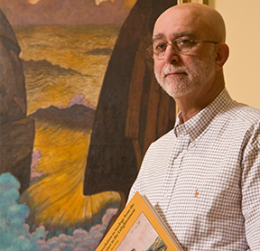Gary Rosenberg, Ph.D.
Associate Professor Emeritus, Adjunct Instructor

Associate Professor Emeritus, Adjunct Instructor
I map the distribution of trace elements in shells, teeth, and bone with digital electron microscopy to determine how both physiology and environment influence skeletal form, crystallography, growth, and composition. At upper right is an image of the prismatic crystals in the outer shell layer of the blue mussel, Mytilus sp (SEM image courtesy Dr. Joseph Carter, University of North Carolina). The crystals are 3-9 µm in width. At lower left is an x-ray map showing the distribution of Mg (blue) and S (white) in the outer shell layer of the mussel. These trace elements are concentrated at the tips of the prisms and may actively control the growth of the crystals (compositional map in collaboration with Monsanto Chemical Co., St. Louis).
These studies, in combination with our studies of the metabolism of bivalves, will help us develop proxies for the metabolism of fossil molluscs.
A long-term goal is to continue to develop a generalized model of shell growth integrating skeletal composition, metabolism, and shape that I began with colleagues and which culminated in our publication, Rosenberg et al 2001 (see below). I am also studying the microstructure and chemistry of teeth and bone in order to understand various afflictions of mineralized tissues.
I study art history for clues to help us understand the origin of modern geologic thought in Western Europe. I have compared the geometric representation of spatial relationships that European Renaissance artists developed (see Leonardo da Vinci's drawing of the hills of Tuscany below), with the meditative images that eastern cultures produced. I believe these different ways of viewing nature help to explain why the Scientific Revolution took place first in Europe and not in the East.
Leonardo da Vinci used geometry to show the structure of the hills of Tuscany, as the colored overlay reveals.
From Rosenberg, 2001, “An Artistic Perspective."
Rosenberg. G.D. and Tubergen, L.B., 1996, Sex-related differences in the composition of otosclerotic stapes: American Journal of Otolaryngology 17, 709-712.
Rosenberg, G.D., 1997, A lesson in plate tectonics from art: Journal of Geoscience Education 45, 137-146.
Rosenberg, G.D., 1997, Finding fossils in fossil abstractions at Dinofest, in D. L. Wolberg, E. Stump, and G.D. Rosenberg (eds.), Dinofest International Proceedings: Academy of Sciences, Philadelphia, pp. 559-568.
Rosenberg, G.D., 1997, How long was the day of the dinosaur? And why does it matter?, in D.L. Wolberg, E. Stump, and G.D. Rosenberg (eds.), Dinofest International Proceedings: Academy of Sciences, Philadelphia, pp. 493-512.
Rosenberg, G.D., 2000, Making space for art in the earth sciences: Journal of Geoscience Education 48, 273-275.
Rosenberg, G.D., 2000, More to earth science than meets the eye: Journal of Geoscience Education 48, 349-351.
Rosenberg, G.D., Hughes, W.W., Parker, D.L. and Ray, B.D., 2001, The geometry of bivalve shell chemistry and mantle metabolism: Bulletin of the American Malacological Society 16, 251-261.
Rosenberg, G.D. 2001. An artistic perspective on the continuity of space and the origin of modern geologic thought, Earth Sciences History, 20:127-155.
Rosenberg, G.D., ed., 2009. The Revolution in Geology from the Renaissance to the Enlightenment: Geological Society of America Memoir 203, 283 p.
Rosenberg, Gary D. 2009. Introduction, in Rosenberg, G.D., ed., The Revolution in Geology from the Renaissance to the Enlightenment: Geological Society of America Memoir 203: 1-11.
Rosenberg, Gary D. 2009. The measure of man and landscape in the Renaissance and Scientific Revolution, in Rosenberg, G.D., ed., The Revolution in Geology from the Renaissance to the Enlightenment: Geological Society of America Memoir 203: 13-40.